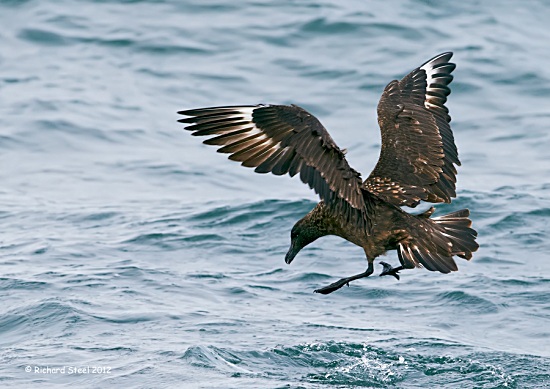Site menu:
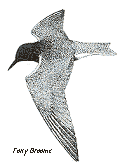
September 2012 Newsletter
Tangled up in Knots.
August Bird News.
Forthcoming Events.
Latest Newsletter.
Following colour ringed migratory shorebirds around Europe.
Part 2: Tangled up in Knots.
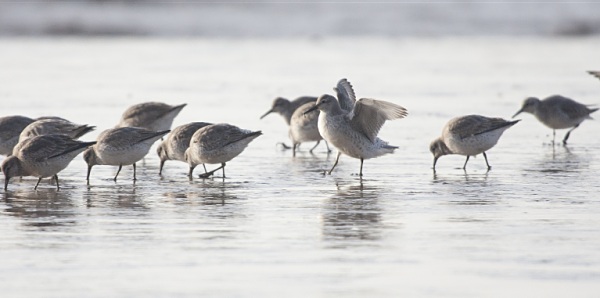
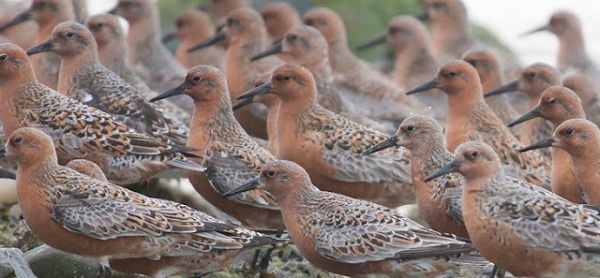
Summer plumaged Knots at Porsanger, Norway, above bottom, © Matt Thomas
By Matt Thomas
A grey murk hangs low over the Clwydian ridge on the far side of
the mudflats, it seems to be sucking the colour from the hills,
everything is tending towards monochrome. The mud itself is a hundred
shades of grey that seems as short on life as it is on colour. And the
cold; fierce and at times aggressive is all encompassing. Any chink in
fleecy armour is ruthlessly punished. The wind comes sweeping around
the Point of Ayr to amplify the chill, stealing heat and delivering
rain. Few would regard this scene as inviting, more one to avoid, but I
can’t dodge it. I have to be there.
Last month, after
reading part one of this pan-European migration research epic you will
know how much I enjoy the study of migratory shorebirds using colour
ringing. In fact my enjoyment seems to be blurring into more of an
obsession that will see me out on the estuary in the foulest of
conditions.
So, encased in several layers of thermal
clothing, hat pulled down over protesting ears and double-gloved, I
hoist the telescope over my shoulder and trudge down to the shore. The
flats that seemed devoid of life at first glance are anything but, and
while there are no colour ringed Black-tailed Godwits striding around
the inter-tidal mud today, there are still thousands of waders present.
Some of these will be colour marked too; Blackwits are not the only
species under investigation. Today’s target is Knot.
Matching the greys of the estuary mud with their unassuming winter
plumage the Knot, Claidris
canutus, can sometimes be overlooked when more colourful
or boisterous species are around.
People
often ignore the individual Knot only really taking notice when they
assemble into a huge flock and take to the air. Traumatized by a
Peregrine attack the birds explode from diligent feeding, their take
off sounding like a round of applause breaking out. Then, once
airborne, their manoeuvres are spectacular, spiralling and jinking in
animated waves of charcoal grey they look like a puff of smoke pulled
along by the whims of the wind. The sound of so many pairs of wings
ripping at the air in unison is like a sheet of canvas being torn to
shreds. This is when we seem to appreciate these birds most, in their
moments of sheer terror, these episodes often culminating in death for
one of the flock.
However, I am more interested in looking
at each of this Calidrid congregation one by one. As awesome and
inspiring as these aerial shows are I am hoping that the Knot will
remain undisturbed for the next few hours so I can search for colour
ringed individuals amongst the 4,000 or so birds on the mud in front of
me.
Through my binoculars the birds look somewhere between
ant-like bugs and beaked mice, zipping at speed across the slick
surface of the mud in a variety of seemingly random directions. This
makes the idea of finding and reading a colour ring combination on
their tiny legs seem fanciful. But, once the tripod legs are splayed
and my feet are planted as firmly as the soggy sand allows, I bow my
head to the scope, feel the snug rubbery fit of the eyecup and the
birds come to sharp focus through layers of polished glass. Now I can
see each tarsus and tibia in vivid detail. The hunt begins.
There
are six subspecies of Red Knot that breed on windswept tundra across
much of the Arctic. The birds before me, like almost all of the birds
that visit the Dee in winter, belong to the islandica race. These birds
nest in the far north of Arctic Canada and along the coast of eastern
Greenland.
Most of these islandica birds will use Iceland as
a staging post on their northward migration, but some choose a
different route, heading to eastern Greenland and the highest parts of
Arctic Canada via a place called Porsanger in Northern Norway. It is
the most northerly regular spring staging area for knots in the world.
Here birds are colour ringed in an effort to learn more about the
origin, distribution and survival of this group of Knots. Some of these
birds have been seen on the Dee and it is them that I am looking for.
Each
marked bird has a red ring on its right tibia and on the left tibia is
a yellow ring with a tab containing a unique 3 letter code. For a
complete record all 3 digits must be read in order from left to right.
No two codes are the same allowing individual birds to be tracked on
their migration. These codes are tricky to read, the birds are swift in
their movements over the mud and the engraved letters small, but this
just adds to the challenge and makes obtaining a successful record all
the sweeter.
I remove my hand from its woolly cocoon long
enough to start a new page in my notebook. I enter the date, Feb 2nd,
time (13.30) and the approximate number of birds present. I’m joined on
the beach by my colleague Chris and together we scan the flock.
Concentration and cold render us mute. A glance to our left and right
confirms we are the only people on the shore. The only sounds come from
the birds. Their feet and bills patter through the mud with a wet
slapping sound as they make frequent dashes and probes for food. They
communicate to each other with calls that resemble a Jackdaw and a
clucking hen. The birds are close; I feel that we are going to get a
sighting. Sure enough a flash of yellow ring is spotted and, after a
few minutes following the bird through the telescope, we both agree on
the full code: Yellow (ELY) – Red.
Back from the beach and
firmly ensconced in a warm office I waited with a steaming cup of
coffee for the feeling to come back to my fingers, toes, nose etc. Once
re-heated I composed the email to the Norwegian Knot Project leader
with details of our sighting. Jim Wilson is a member of the
International Wader Study Group executive committee and a committed
wader-ologist and has been running this project for the past 7 years.
Observers
on the Dee have contributed records of his birds for several winters
and so he had decided to pay us a visit in November 2011 to see where
some of his birds were ending up. Richard Smith and I showed him around
the best Knot sites during his week long stay and over dinner on his
final night came an invite to join him in Norway to take part in
fieldwork during an expedition to Porsanger in May 2012. There was no
way I was going to turn down such an opportunity and I accepted there
and then, any other arrangements would have to be juggled! The rest of
last winter was spent looking for his birds culminating in the sighting
I described above.
Eventually, May rolled around and Chris
and I packed our bags and, leaving the Dee basking in a mini heatwave,
we prepared for two weeks several hundred miles inside the Arctic
Circle, around 70° north.
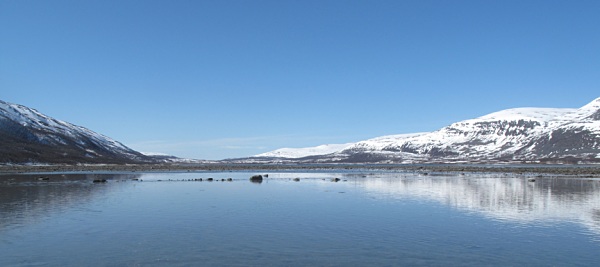
We were staying in a small
village
called Veidnes at the mouth of Lille Porsanger. The accommodation could
only be described as authentic. A traditional Lap tent with a carpet of
reindeer skin and fitted with a wood burning stove for warmth was our
home for a stunning fortnight. During our stay we saw no darkness, the
sun nearly setting, but not quite. Around us Sea Eagles patrolled sheer
cliffs, lemmings scuttled across the tundra, reindeer herds grazed
scanty vegetation and Snow Buntings – rare winter visitors on our
patch- were garden birds!
On the fjord the Knot had arrived
a couple of days before us, zooming up from their staging post in the
Wadden Sea on the tail of a southerly gale. I am well used to
seeing big numbers of Knot, often up to 25,000. But I was not prepared
for the sight and sound of 50,000 summer plumaged birds. They looked
like a totally different species. Gone were the soft grey tones of
winter, replaced by smouldering ember-red breeding colours, just
stunning. Once we had got over the spectacle of numbers, striking
appearances and set up our camp we got down to work. We headed straight
out on the mudflats looking for marked birds and investigating places
to try and catch and ring some more.
The scenery was
breathtaking. Huge expanses of inter-tidal mud were flanked by snow
clad craggy mountains. During our stay Spring arrived. Rising
temperatures melted snow that swelled rivers and triggered rumbling
avalanches. This left vast patches of black scree slopes exposed making
the hills look like huge Fresian cows sleeping next to the clear blue
waters of the fjord.
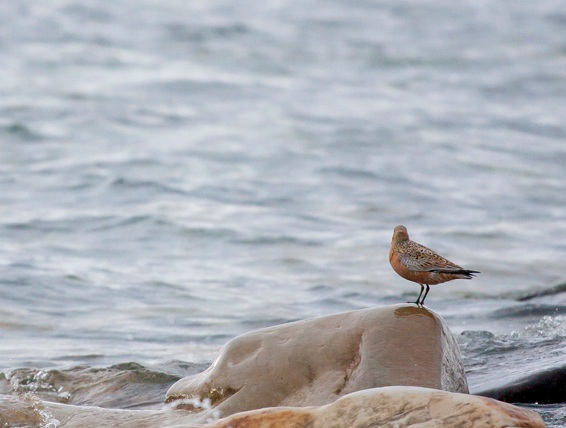
Over our two week expedition we were
able to contribute much more data to the Norwegian Knot Project. Our
top priority was to find and record ringed birds and while collecting
this data I had an amazing encounter with an old acquaintance.
The
heading in the notebook was May 25th. Time was recorded as 13.30, and
about 500 birds on the rocky shore. I was looking through the telescope
at the flock when I spotted a ringed Knot. It was hard to follow; it
kept disappearing behind a large boulder that was particularly heavily
bearded with yellow-brown slimy seaweed. Like the other birds on the
beach it was hoovering up shellfish and worms at a rapid rate.
Eventually it briefly moved into clear view, I got a reasonable look at
it and was able to read the first letter of the code on the yellow
ring. E. More following with the scope and I read the second letter. L.
Finally it wandered into the open and I could complete the code. Y. I
looked again, double and triple checking. The code was definitely ELY.
This rang a big bell in my head and I started to flick back through my
notebook until I reached the page headed Feb 2nd. There it was,
scrawled in scratchy black biro ink, Yellow (ELY) – Red. Confirmation
that I was looking at the same bird Chris and I had seen on the Dee!
112
days after I first saw it, there I was sharing a beach with this bird
again, crunching over the same shingle, squelching through the same
mud. I was aware there was a chance that I would see a bird in Norway
that I had seen on my local patch but I hadn’t seriously entertained
the idea. It was an odd set of feelings, seeing this bird again, a
cocktail of surprise, wonder, excitement, respect and sense of mild
concern. I found myself feeling strangely connected to this bird, I
wanted it to survive the rest of its perilous journey to the high
Arctic and to successfully rear chicks.
Our meeting
obviously made more of an impression on me than on ELY. As I got all
misty eyed it continued to fuel up for the remainder of its migration,
coming across an unusually meaty worm in the grainy grey gloop and
gobbling it up before flying off with the rest of its flock to a bay
further down the coast. Leaving emotion aside I moved on to the next
site to look for more ringed birds, however, I did spend the rest of
the day grinning from ear to ear and was quick to tell the story of our
reunion to anyone who’d listen.
This sentimental anecdote
aside, what are we learning about the Knots of Porsanger fjord from
this
colour ringing project? Below I summarise some of the preliminary
sightings kindly sent to me by Jim who has crunched the numbers and
analysed the data since our return south.
A link with
Iceland is emerging. Some of the birds ringed in Norway appear in
following years in Iceland but not, so far, in Norway again. This
“switching” is puzzling, has only recently been discovered and will
require further investigation. During our trip 9 sightings came in of
Norwegian ringed birds in Iceland. Four of these had not been sighted
in Iceland in previous years. No birds ringed in Iceland, no Porsanger
marked birds which have been sighted in Iceland and no Dutch ringed
birds which have a history from Iceland were seen by us in Norway. So
at the moment the data suggests that the switch to Iceland is a one way
movement – they do not come back. However the Porsanger population
seems stable. Odd!
During our expedition we made 431 flag
readings of Porsanger marked birds involving 255 individuals. We also
made a lot of density counts of flagged birds (how many flagged birds
in the flock on view). From previous ringing between 2006-2009 we
sighted 28% of birds assumed to be still alive (working on a 15% rate
of mortality). As it was known that Porsanger birds are spread
throughout the Norwegian population and that an unknown number switch
to staging posts in Iceland it was a good effort to see so many.
Hopefully it should now be possible to determine some mortality
estimates as over 50% of birds marked in Porsanger fjord have been seen
there in later years.
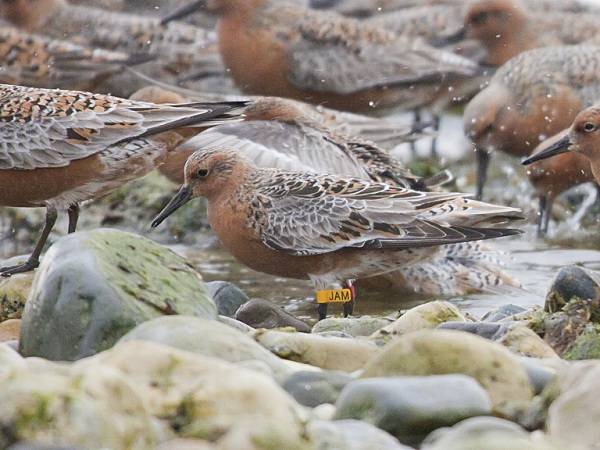
Up until and including
20th May there
were estimated 40,000 Knots in the Lille Porsanger/Veidnes complex.
However, on each evening tide birds were seen leaving in small flocks
towards the east in typical migration mode on a bearing of about 80º.
Later in the trip 5,000 were found in Varangerfjord 150 km to the east.
Varanger
was almost certainly the destination of these birds. 25 individual
Porsanger ringed birds were seen in Varanger between 23rd and 26th May.
11 of the 25 (44%) had been sighted in Lille Porsanger between 10th and
19th May and 2 Dutch ringed birds were also spotted there which had
originally been sighted on 19th May 2012 in Lille Porsanger. This
nicely demonstrates the within year link between these 2 sites.
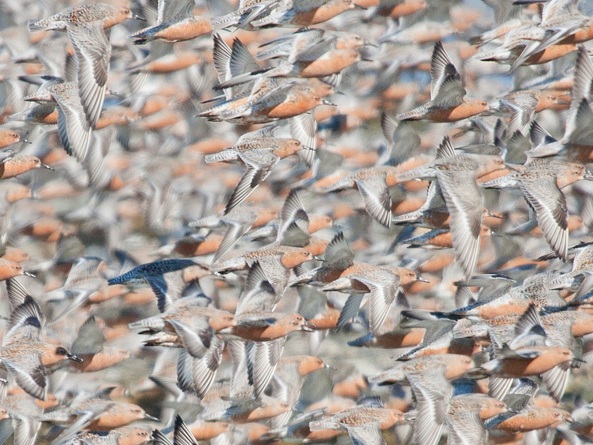
When
birds fly to Varanger they move 150 km to the east – as they then fly
west again at the end of May towards Greenland they are adding 300 km
to their migration distance.
To compliment the observations
of the Knots several transects to sample food availability were made at
various muddy locations up and down the fjord. Paired samples were
taken with a 5 cm diameter core to a depth of 4-5 cm at 100m intervals.
They were sifted through a 2mm sieve to find the creatures the Knot
were feeding on.
1-3mm shells are probably lost in sieving,
and with the proviso that the growth rate of Baltic Tellin was unknown
to us, a preliminary look at the data suggests that either there has
been no Tellin population growth in Lille Porsanger in recent years, or
more likely, the area has been grazed out over the last 3-4 years by
the thousands of Knots which have been seen there. Surprisingly, there
were many large Tellins at Lille Porsanger, which suggests that there
was a period in the past without grazing. Indeed during 2005-2007 fewer
Knots were found there and the large shell size does suggest that there
must have been a period with few Knots and this nicely ties in with
observations made during that time. Conversely the absence of large
shells at other locations suggests a period of heavy grazing. This
information suggests that the birds make some movements in relation to
food availability, but there may be other factors at play here too
including…
…Peregrines! In Porsanger Peregrines are migrants
that arrive at about the same time or just after the Knots. Knots are
probably their main, perhaps only, food source in the last two weeks of
May. A migration ready Knot would be an ideal energy filled meal for a
raptor about to start its breeding cycle. During our trip we saw
frequent Peregrine attacks and sometimes birds were suddenly alarmed,
probably by a Peregrine which we did not see. Birds reacted strongly to
Peregrines and were seen to move several kilometres after an attack. It
is possible that Peregrines are driving the distribution of Knots
around the fjord in conjunction with the food supply.
More
analysis of the distribution of Peregrines and Knots over previous
years is required. As there are now fewer Peregrines nesting on the
west side of Porsanger fjord and they are more common on the east, the
impression is that the Peregrines are following the Knots and establish
their nesting sites where they find the big flocks in the spring.
However, all this is complicated by changing quantity in food
resources. From 2004-2008 many Knots were on the West side of
Porsanger fjord which has since been deserted. It will be interesting
to
see what areas the Knots use in 2013.
So there we are, for
now my story is complete, but as the last line of the previous
paragraph suggests there is more work to do and more places to see.
We
have answered some questions but we have discovered more that need our
thought, research and discussion. Further expeditions may be required.
Is there anything more exciting than that?
In the meantime
we can all help. Please look for colour ringed birds when watching the
waders on the estuary. Each sighting is vital, the information gained
can help to conserve these wonderful birds and protect the special
wetland habitats that they need and we enjoy. Email records to:
richard@deeestuary.co.uk
Matt Thomas
http://deebirder.blogspot.com
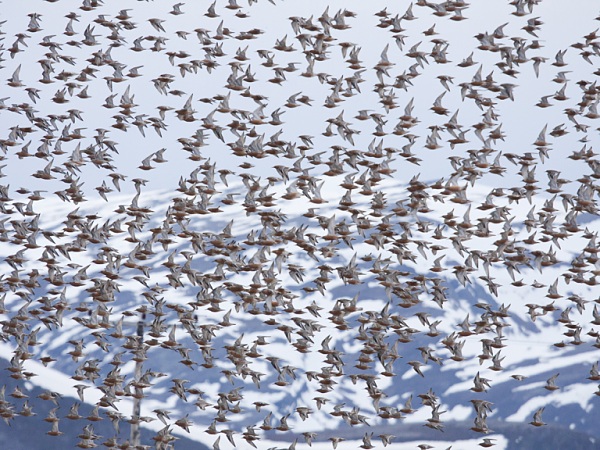
August Bird News
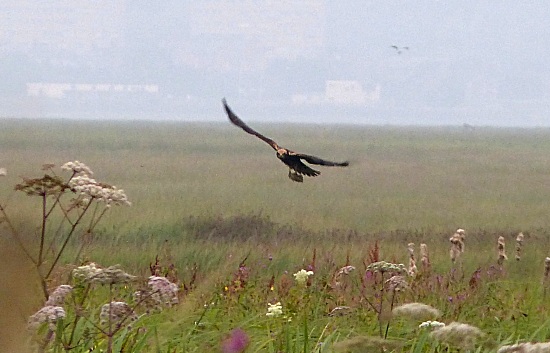
Without actually checking I would guess we've had more Marsh Harrier sightings this month than we've ever had before! It's reckoned we've had six here - two wing tagged juveniles, 1 male, 1 moulting female, 1 juvenile not wing tagged, 1 female. The wing tag of one of the juveniles has been read and it was one of a brood of three tagged this year in East Anglia, a remarkable and unexpected north-west movement.
After the massive fall of Willow Warblers on Hilbre in early May we didn't expect to see another one this year, but that's exactly what we got with an estimated 700 coming through on the 14th, they managed to ring a remarkable 165 of them at the Bird Observatory.
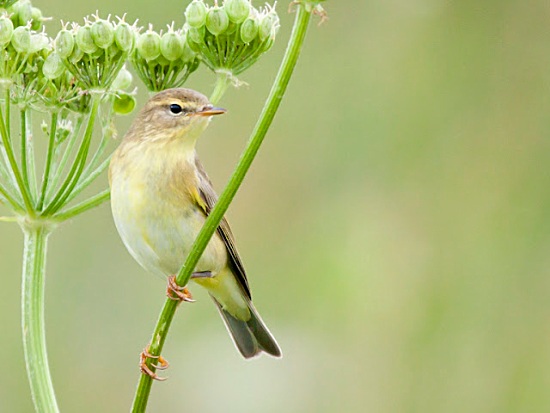
© Matt Thomas, see 'From the Muddy Banks of the Dee' Blog.
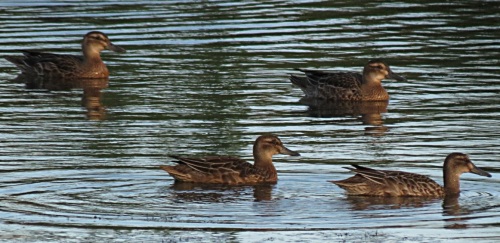
Apart from the terns there were no large movements of sea birds, but up to five Arctic Skuas were around for most of the month with one or two Great Skuas passing through.
What to expect in September
Strong winds can also bring in plenty of other good birds and expect to see Arctic Skuas in double figures, Great, Pomarine and Long-tailed Skuas, maybe a Sooty Shearwater or two, Sabine's Gulls and Grey Phalaropes.
Last year was a classic for Curlew Sandpipers with large numbers particularly at Hoylake and IMF/Burton Mere Wetlands - see November 2011 Newsletter - it would be fantastic to get the same again this year!
September is often an excellent month for rarities, and there can be such goodies as marsh terns, Wryneck, rare Warblers and rare Waders. Other than that expect to see good numbers of Greenshank and Spotted Redshanks, plus Hen Harriers and Short-eared Owls returning to the marshes.
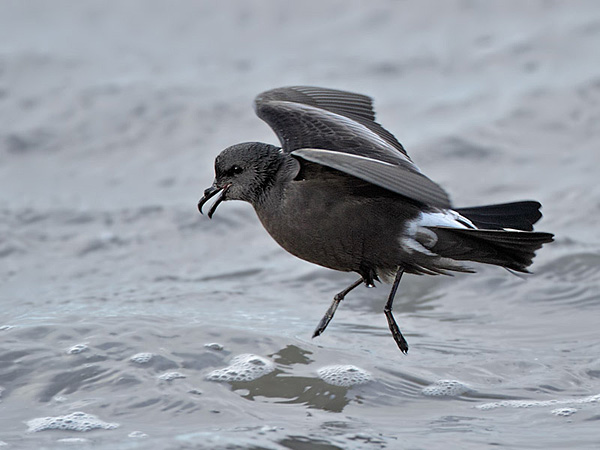
Forthcoming Events
September Highest Spring Tides (Liverpool)
Also
see Tides
page.
17th September, 12.34hrs (BST), 9.7m.
18th September, 13.13hrs (BST), 9.8m.
19th September, 13.54hrs (BST), 9.7m.
Forthcoming Events
Organised by the Wirral
Ranger Service , Flintshire Countryside Service and/or the
RSPB:
All these events and walks have bird interest, even those not
advertised specifically for birdwatching. No need to book for these
events unless specified - please check below.
Also see 2012 Events Diary.
LiverBird Watching and Nature Discovery Crusies 2012 - Click here for details.
Saturday 1st September, 6pm - 8pm, An Evening with Egrets
at Burton Mere
Wetlands RSPB.
Price: £2 RSPB members, £5 non-members.
Booking essential.
The
Dee Estuary is home to the largest number of little egrets in the
entire North of England and believe it or not they all roost in one
small group of trees near to Burton Mere Wetlands.
So come along
for a short talk on the trials and tribulations of little egrets in the
UK before a gentle stroll down to the Marsh Covert Hide to watch as
hundreds of egrets come "home" to roost.
This truly is one of the best wildlife spectacles at this time of year
in the north.
Places are limited so book in advance to avoid disappointment.
Cost includes a cuppa and biscuits.
Saturday 8th September, Hilbre Low Tide
Birdwatch, 8:00am start to 1:30pm latest.
Join the Rangers, the RSPB and staff from the Hilbre Bird Observatory
on this low tide birdwatching event on Hilbre Island.
Booking
essential. Phone (0151) 648 4371.
Saturday 22nd September and Sunday 23rd September. Happy
Birthday at Burton
Mere Wetlands.
10am - 4pm
Price: Free
Help
us celebrate Burton Mere Wetlands' 1st Birthday weekend as there will
be lots going on including family activities, guided walks, prize
raffle and of course there will be delicious homemade cake! The wardens
are hosting free guided walks about how and why the reserve was
developed, the walks will start at the reception building and last
approx 1 hour.
And best of all in the spirit of celebration its free entry for
everyone.
Saturday 29th September, The Big Seawatch, Hilbre.
Join
the Rangers, staff from the RSPB, Hilbre Bird Observatory and the Sea
Watch Foundation for a day on Hilbre looking for seabirds, waders and
cetaceans that inhabit our wonderful coast. We will be
staying on
Hilbre during high tide, giving us the best chance to see them with
experts on hand! There is a small charge of £1.50 for this
event
which includes tea/coffee.
Booking Essential.
Please ring (0151) 648 4371.
Tuesday 2nd October. “The Thurstaston
Circle”.
10am start at the Visitor
Centre, Thurstaston.
A guided birdwatch along Thurstaston Shore, across Heswall Fields and
back to the Visitor Centre via the Wirral Way.
We will be following the rising tide along Thurstatson Shore looking at
the birds being pushed towards the marshes at Heswall.
Warm waterproofs and good walking boots/Wellingtons recommended. Bring
some binoculars if possible.
(0151) 648 4371 for more info.
Saturday 6th October and
Sunday 7th October. Skydancers at Parkgate
- 12 noon until dusk.
Skydancer
is an exciting new four-year project aimed at raising awareness and
promoting the conservation of hen harriers in the north of England.
The
Dee Estuary is a vital wintering ground for these amazing birds and is
the best place to see them from October through to March.
Most
people have never seen a hen harrier, but once seen it is rarely
forgotten. This bird is a beautiful, agile hunter, and its aerobatic
sky dances are among the most awesome spectacles in nature.
Unfortunately,
with only a handful of pairs still breeding successfully in England,
the hen harrier is currently a species on the brink.
Come along to
Parkgate to find out more about the hen harrier story and what you can
do to help save hen harriers before it's too late!
Look for the
RSPB Love Nature marquee along the main promenade at Parkgate where
friendly staff and volunteers will be with telescopes and binoculars
plus family activities, free information and more: http://www.rspb.org.uk/skydancer/
Directions: The "Donkey Stand" opposite Nicholls Ice-cream shop on The
Parade (B5135), Parkgate, Cheshire.
